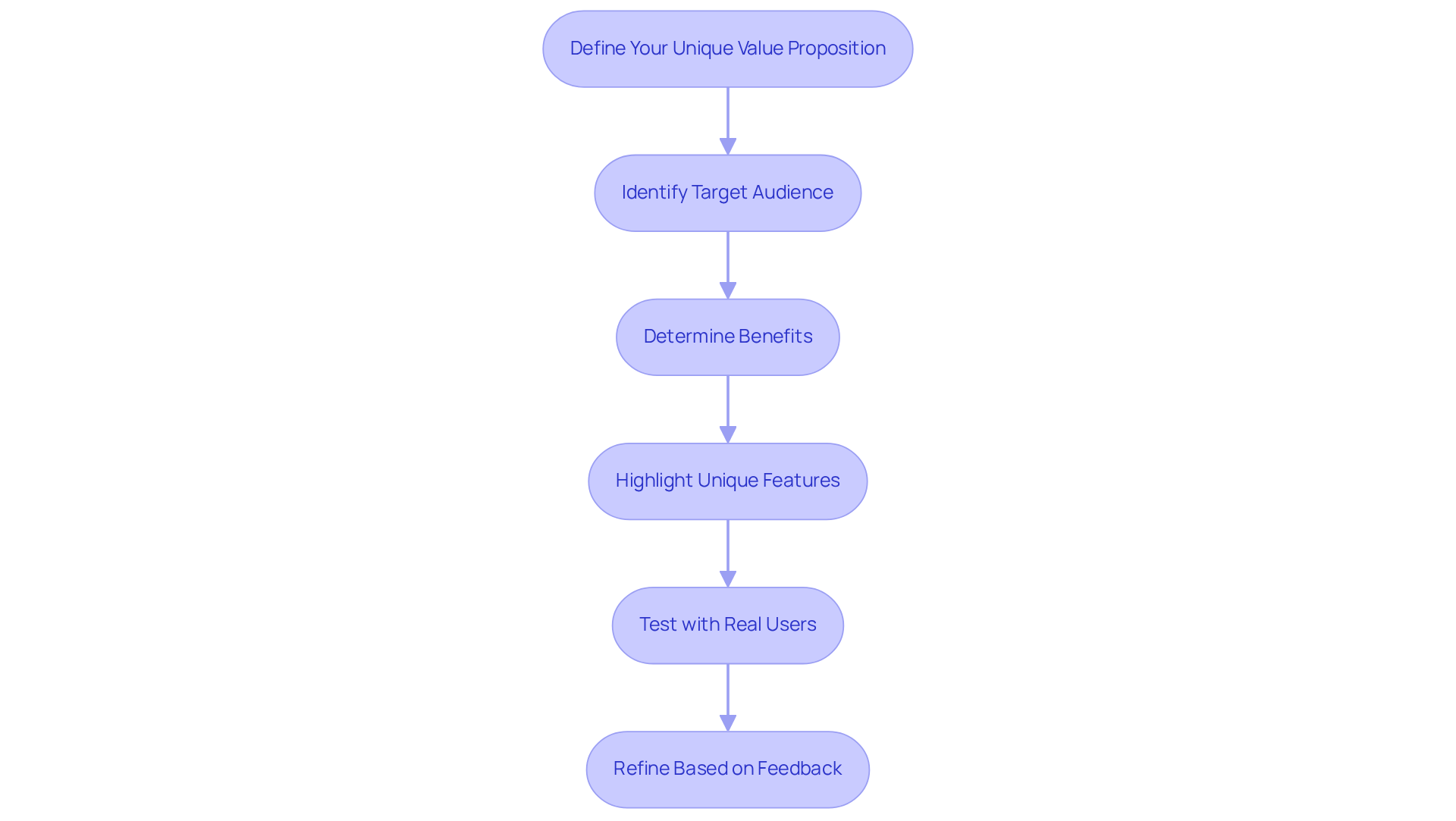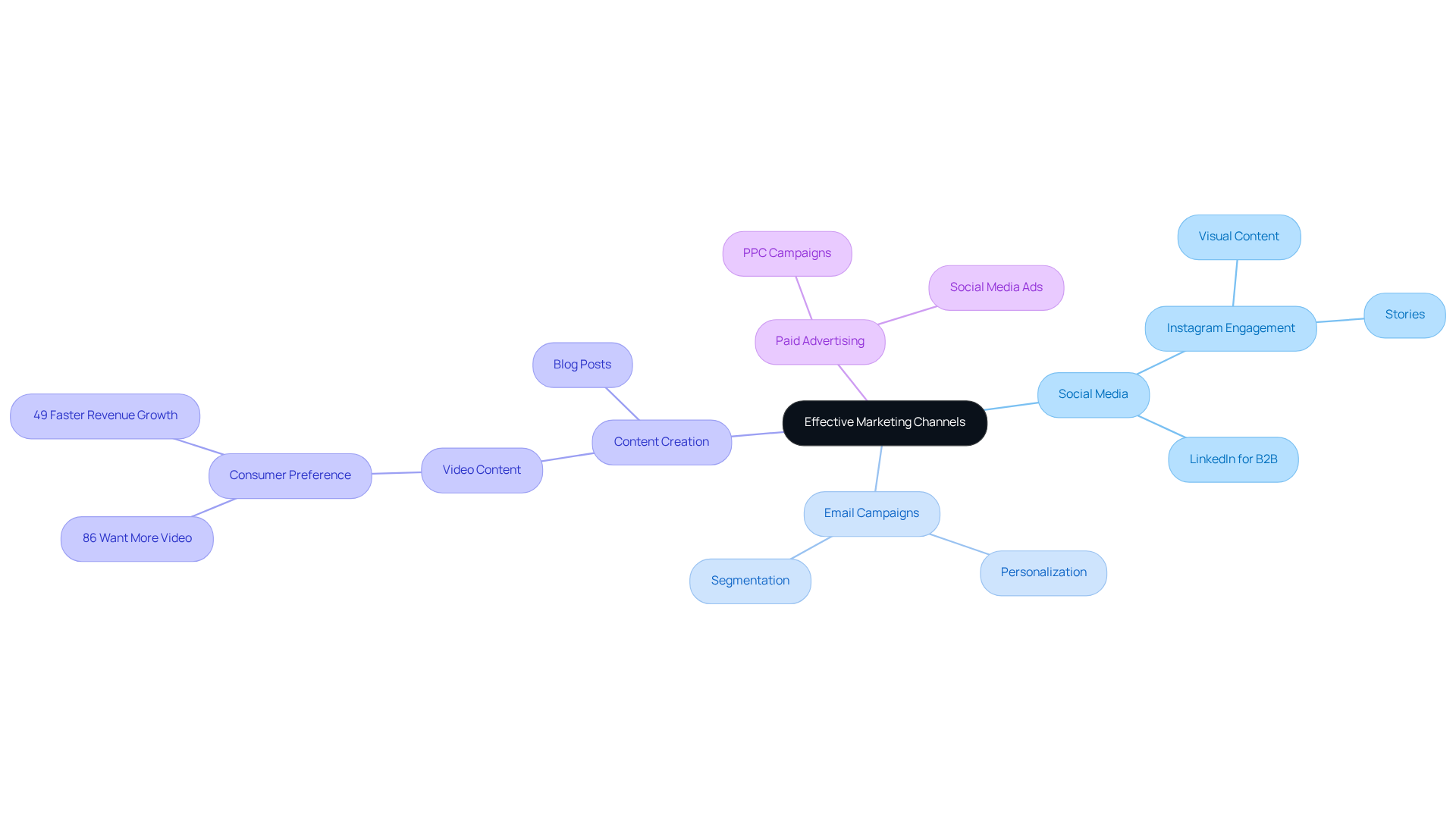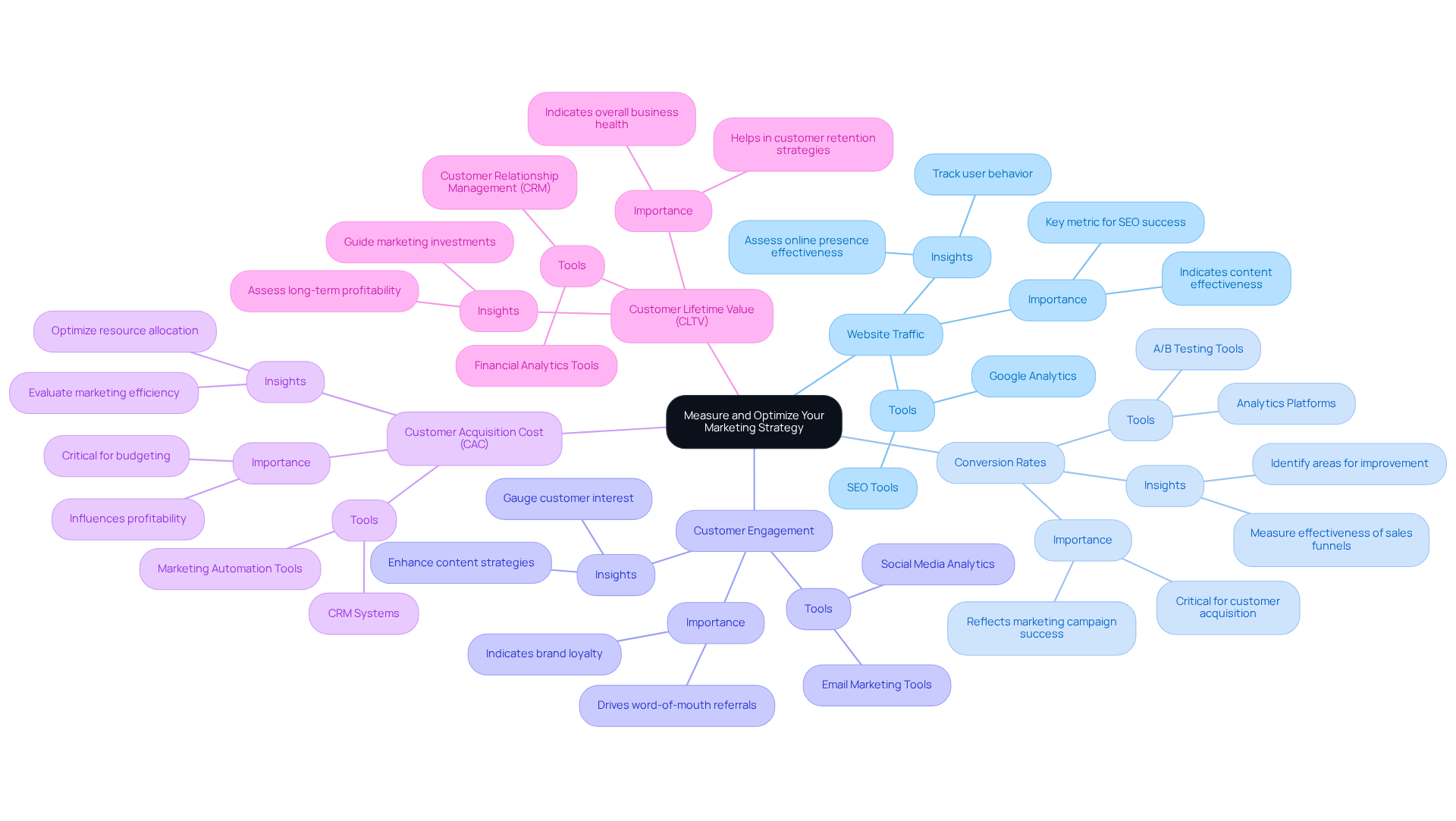Overview
This article serves as a nurturing guide for startup founders looking to master marketing strategy and branding through five essential steps. Many founders struggle with effectively reaching their target audiences, which can lead to feelings of frustration and uncertainty. By understanding these pain points, we can explore how crucial it is to:
- Define a unique value proposition
- Develop a cohesive brand identity
- Choose effective marketing channels
- Measure performance
Each of these elements plays a vital role in enhancing customer engagement and driving business success in today’s competitive landscape. Together, we can navigate these challenges and foster a supportive environment for growth and connection.
Introduction
Navigating the journey of crafting a successful marketing strategy and brand identity can feel like a daunting challenge for many tech startups. When 76% of consumers express a preference for brands they feel a connection to, it becomes increasingly clear that understanding the fundamentals of marketing and branding is not just important—it's essential. This article explores five vital steps designed to empower startup founders like you to:
- Define your unique value propositions
- Cultivate cohesive brand identities
- Select marketing channels that truly resonate with your target audiences
But what happens when the strategies that once appeared promising start to lose their effectiveness? By delving into the complexities of marketing effectiveness and optimization, we can uncover the path to sustained success, even amidst the ever-shifting landscape of consumer expectations. Together, let’s embark on this journey of growth and connection.
Understand Marketing Strategy and Branding Fundamentals
To thrive in their marketing strategy and branding, many tech startup founders face a fundamental challenge: understanding the basic concepts that drive success. A strong marketing strategy and branding begin with:
- Identifying your target audience
- Understanding their needs
- Determining effective outreach methods
As we look toward 2025, it’s essential to prioritize this understanding; after all, 76% of consumers prefer buying from brands they feel connected to. As Philip Kotler wisely states, "The aim of marketing is to know and understand the customer so well the product or service fits him and sells itself."
Branding is an essential component of any marketing strategy and branding, focusing on crafting a unique identity that truly resonates with your audience. Investigating successful companies within your sector can offer valuable insights into their positioning and customer engagement approaches. For instance, consider RNO1's partnerships with companies like Highline and Cirkul. Their collaboration demonstrates how customized digital experiences can significantly enhance customer engagement and boost sales.
Client testimonials from Jared Schwitzke and Leigh Ann Tucker further highlight RNO1's ability to transform branding strategies and elevate digital marketing effectiveness. This foundational knowledge is not just theoretical; it will inform your marketing strategy and branding decisions and empower you to create a compelling narrative that stands out in a competitive landscape. Remember, you are not alone in this journey; with the right insights and support, you can navigate these challenges and thrive.

Define Your Unique Value Proposition
Defining your Unique Value Proposition (UVP) can feel daunting, especially when you’re trying to stand out in a crowded market. Many founders struggle with pinpointing what truly sets their product or service apart. It’s essential to concentrate on the challenges your intended audience faces and express how your offering resolves these issues. A helpful framework to consider is:
- 'We help [target audience] achieve [benefit] by [unique feature].'
This clarity not only distinguishes your identity but also resonates deeply with potential customers.
Testing your UVP with real users is an invaluable step. Their feedback will guide necessary refinements, ensuring your proposition aligns with market needs. A compelling UVP is not just a statement; it becomes the foundation of your marketing strategy and branding, driving engagement and fostering loyalty. Take inspiration from successful examples in the tech industry, such as Airbnb's 'Belong Anywhere.' This illustrates how a well-crafted UVP can significantly enhance customer acquisition and retention. In fact, a well-crafted value proposition could improve customer acquisition by 40%, underscoring its importance in driving business success.
However, it’s important to be mindful of common mistakes when crafting your UVP. Avoid being too vague or focusing solely on features instead of benefits. Remember, a strong UVP is dynamic, evolving with customer expectations and market trends, making it essential for sustained growth. As Jeff Bezos wisely noted, a company's reputation is built on what people say when it's out of sight. This highlights the critical role of a strong UVP in shaping perception. Additionally, tools like the F/MS AI Business Model Canvas Tool can assist startups in refining their value propositions, ensuring they remain relevant and compelling. You’re not alone in this journey; many have walked this path and found success. Embrace the process, and let your unique value shine.

Develop a Cohesive Brand Identity
To establish a strong identity, many startup founders face the daunting task of creating a logo that truly encapsulates their essence. It's essential to choose a color palette that resonates with your audience and define typography that reflects your unique personality. These elements should harmonize with your unique value proposition (UVP) and appeal to your target demographic. Moreover, it’s crucial to develop a unique identity that conveys your message consistently across all channels.
Creating thorough guidelines for your identity is a vital step. These guidelines should detail how to apply your logo, color palette, and typography in various contexts, ensuring that your branding remains cohesive as your startup evolves. Consistency in branding can significantly boost revenue by 10-20%, underscoring its importance in building trust and recognition.
Consider successful companies like Apple and Nike, which exemplify the power of cohesive marketing. Apple’s minimalist logo and consistent use of color have contributed to its status as the world’s most valuable label. Similarly, Nike’s iconic swoosh, initially designed for just $35, has become synonymous with athletic excellence.
As branding specialists point out, color improves identification by 80%, making it essential for conveying the right message and emotional appeal. Furthermore, 75% of respondents believe that a logo's look and feel can determine a brand's success. Therefore, investing time and resources into these foundational elements is vital for tech startups aiming to establish a strong marketing strategy and branding in a competitive landscape. As Courtney Bozigian states, "These branding statistics emphasize the significance of nurturing emotional connections with your viewers.

Choose Effective Marketing Channels and Tactics
To effectively connect with your intended group, it’s important to recognize the challenges many face in navigating promotional channels. Assessing avenues such as social media, email campaigns, content creation, and paid advertising can feel overwhelming. Understanding where your target group spends their time is vital; for instance, smartphones account for over 77% of retail website visits worldwide, and platforms like LinkedIn play a crucial role in B2B interaction. This realization can stir feelings of uncertainty, but customizing your marketing strategy to align with your identity and customer preferences can provide clarity and direction.
Consider this: if your audience primarily engages on Instagram, focusing on visually appealing content and stories is essential. After all, 86% of consumers express a desire to see more video material from brands they appreciate. Furthermore, 49% of businesses report experiencing faster revenue growth when utilizing video content. Outlining specific tactics for each channel, including content types, posting frequency, and engagement approaches, can transform your strategy into a more manageable endeavor. This targeted approach not only enhances visibility but also fosters deeper connections with potential customers, ultimately driving engagement and conversions.
Remember, successful promotion revolves around establishing meaningful connections. As Scott Cook wisely notes, a label is shaped by what consumers express about it, not solely by corporate communication. Gary Vaynerchuk also emphasizes that brands engaging with customers authentically will thrive, underscoring the importance of relationship-building in your promotional approach. By nurturing these connections, you can create a supportive community around your brand, making the journey more rewarding for both you and your audience.

Measure and Optimize Your Marketing Strategy
Establishing key performance indicators (KPIs) can feel overwhelming, especially when you're striving to assess the success of your promotional efforts. It’s important to focus on metrics like:
- Website traffic
- Conversion rates
- Customer engagement
- Customer Acquisition Cost (CAC)
- Customer Lifetime Value (CLTV)
to truly gauge effectiveness. Regular use of analytics tools such as Google Analytics, social media analytics, and SEO tools can provide valuable insights into user behavior, helping you consistently track these metrics. If you notice a dip in conversion rates from a specific promotional channel, it may be a signal to consider redistributing resources or adjusting your approach. This ongoing optimization is vital; startups that regularly evaluate their performance data can identify trends and areas for improvement, leading to enhanced effectiveness. In fact, about 89% of top marketers prioritize key metrics like awareness, engagement, conversion, and retention, highlighting the significance of a data-driven approach. By refining your marketing strategy and branding through actionable insights and aligning them with your overall business goals, you can achieve better results over time and foster sustainable growth. Remember, you're not alone in this journey—many founders face similar challenges, and together, we can navigate these waters to create a thriving future.

Conclusion
Navigating the complexities of marketing strategy and branding can feel overwhelming for startups striving for success in a competitive landscape. It’s a common struggle that many founders face, and understanding the fundamentals is essential. By defining a unique value proposition, developing a cohesive brand identity, choosing effective marketing channels, and measuring performance, startups can build a strong presence that truly resonates with their target audience. Each step in this journey builds upon the last, creating a comprehensive approach that not only attracts customers but also nurtures loyalty and engagement.
Key insights from this guide highlight the importance of truly knowing your audience and their needs. A well-crafted unique value proposition is vital; it should clearly communicate how your offering addresses their challenges. Establishing a consistent brand identity and selecting the right marketing channels can significantly enhance your ability to connect with potential customers. Furthermore, regularly measuring and optimizing your marketing efforts is crucial to ensure that your strategy evolves and adapts to the ever-changing market dynamics.
The journey of building a successful startup is undoubtedly filled with challenges, but by embracing these strategic steps, you can navigate the complexities of marketing and branding with confidence. Remember, you are not alone in this process. Share your experiences, seek insights from industry leaders, and remain committed to refining your approach. The significance of a strong marketing strategy and branding cannot be overstated; they are the cornerstones of sustainable growth and long-term success in our ever-evolving business landscape.
Frequently Asked Questions
What are the key components of a strong marketing strategy and branding?
A strong marketing strategy and branding begin with identifying your target audience, understanding their needs, and determining effective outreach methods.
Why is understanding your audience important for marketing success?
Understanding your audience is crucial because 76% of consumers prefer buying from brands they feel connected to, making it essential for creating effective marketing strategies.
How can examining successful companies help in developing a marketing strategy?
Investigating successful companies within your sector can provide valuable insights into their positioning and customer engagement approaches, which can inform your own marketing strategies.
What is a Unique Value Proposition (UVP)?
A Unique Value Proposition (UVP) is a clear statement that explains how your product or service resolves the challenges faced by your target audience, highlighting what sets it apart from competitors.
How can I test my UVP?
Testing your UVP with real users is an invaluable step, as their feedback will help refine your proposition to ensure it aligns with market needs.
What are some common mistakes to avoid when crafting a UVP?
Common mistakes include being too vague or focusing solely on features instead of benefits. A strong UVP should clearly convey the benefits to the customer.
How can a well-crafted UVP impact customer acquisition?
A compelling UVP can significantly enhance customer acquisition and retention, with studies suggesting it could improve customer acquisition by 40%.
What tools can assist startups in refining their UVPs?
Tools like the F/MS AI Business Model Canvas Tool can help startups refine their value propositions, ensuring they remain relevant and compelling.
How should a UVP evolve over time?
A strong UVP is dynamic and should evolve with changing customer expectations and market trends to ensure sustained growth.




